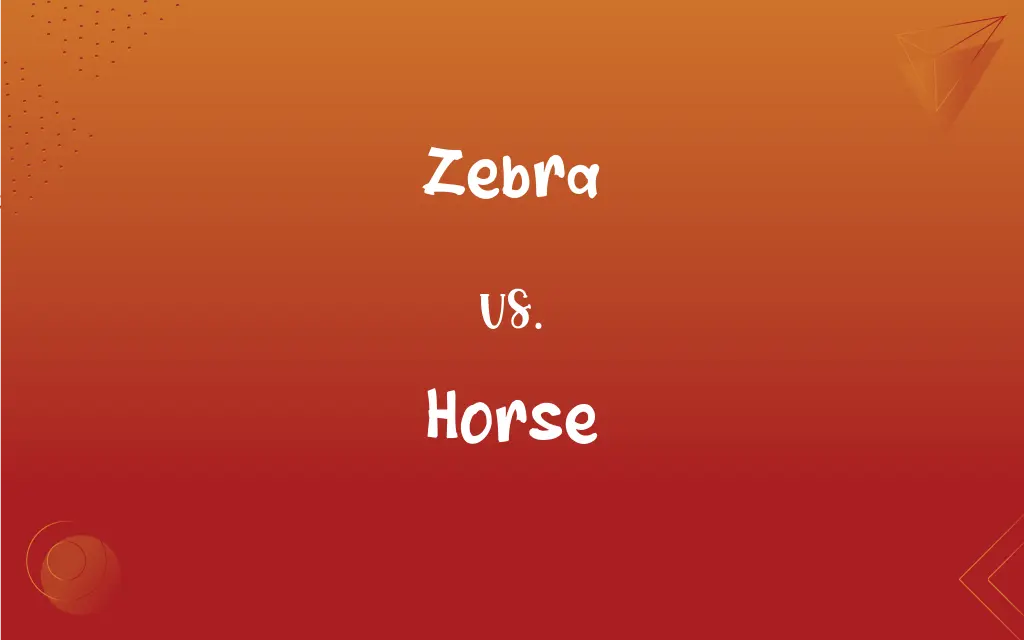Zebra vs. Horse: What's the Difference?
Edited by Aimie Carlson || By Harlon Moss || Updated on June 1, 2024
A zebra is a wild animal with black and white stripes, while a horse is a larger, domesticated animal often used for riding and work.

Key Differences
Both zebras and horses belong to the Equidae family, but they are distinctly different species. Zebras are primarily wild animals originating from Africa, known for their characteristic black and white stripes, which serve as camouflage against predators. Horses, on the other hand, have been domesticated by humans over thousands of years. While they come in various colors and patterns, none possess the unique stripe pattern of a zebra. Horses have been invaluable to humans for transportation, labor, and companionship.
When observing behavior, zebras are generally more skittish and alert due to their wild nature and constant threat from predators. Horses, because of domestication, often have a calmer demeanor, though individual personalities can vary widely.
In terms of size and build, horses are generally larger and have a broader range of body types, from the small and sturdy ponies to the tall and lean racehorses. Zebras have a more consistent size, falling between that of a pony and a medium-sized horse, with a stockier build.
Comparison Chart
Origin & Habitat
Africa; wild habitats like grasslands
Worldwide; domesticated environments
Appearance
Black and white stripes
Various colors, no stripes
ADVERTISEMENT
Behavior
Skittish, wild
Calmer, domesticated
Size
Between a pony and medium-sized horse
Ranges from small ponies to large breeds
Uses
Mostly wild, some in zoos
Riding, work, racing, companionship
Zebra and Horse Definitions
Zebra
A striped animal related to the horse.
The zebra's stripes serve as camouflage against predators.
Horse
An equine animal, often used as a means of transportation in history.
Knights rode horses into battle in medieval times.
ADVERTISEMENT
Zebra
An equine species that's never been truly domesticated.
Unlike horses, a zebra remains largely wild in behavior.
Horse
A large, domesticated mammal used for riding and labor.
The horse galloped across the meadow.
Zebra
A wild African equine with black and white stripes.
The zebra grazed peacefully in the savannah.
Horse
A member of the Equidae family, bred in various breeds.
The Arabian horse is known for its stamina and beauty.
Zebra
An equid known for its distinctive stripe pattern.
Every zebra has a unique set of stripes.
Horse
A hoofed animal often kept for equestrian sports.
She competes in show jumping with her horse.
Zebra
A member of the Equidae family native to Africa.
The plains of Africa are home to several species of zebra.
Horse
A four-legged mammal with a mane and tail.
The horse stood by the fence, waiting for its owner.
Zebra
Any of several swift African mammals of the genus Equus, resembling the horse and having distinctive overall markings of alternating white and black or brown stripes.
Horse
A large hoofed mammal (Equus caballus) having a short coat, a long mane, and a long tail, domesticated since ancient times and used for riding and for drawing or carrying loads.
FAQs
Do all zebras have the same stripe pattern?
No, each zebra's stripe pattern is unique, much like a fingerprint.
Can you ride a zebra like a horse?
While physically possible, zebras are wild and not typically ridden like horses.
Are zebras only found in Africa?
Yes, zebras are native to Africa, though they can be found in zoos worldwide.
Why do zebras have stripes?
Zebras' stripes offer camouflage, confuse predators, and may help with temperature regulation.
Can a horse and zebra interbreed?
Yes, their hybrid offspring are called zorses.
Are zebras social animals?
Yes, zebras typically live in social groups called harems or herds.
Which is faster, a horse or a zebra?
Horses are generally faster, but zebras are agile and have great stamina.
Are there wild horses like zebras?
While most horses are domesticated, there are wild populations, like the Mustang in the U.S.
How do you differentiate between horse breeds?
Horse breeds differ in size, color, temperament, and purpose they were bred for.
Can zebras be trained?
While some zebras have been trained in captivity, they're generally more unpredictable than horses.
Can you keep a horse as a pet?
Yes, many people keep horses as pets, though they require space, care, and training.
Are horses herbivores?
Yes, both horses and zebras are herbivores, primarily grazing on grass.
How long do horses live?
Horses typically live between 25 to 30 years, though some can live into their 40s.
How many toes does a horse have?
Horses have a single toe, or hoof, on each foot.
How many breeds of horses are there?
There are over 300 different breeds of horses, each with its own characteristics.
Why are zebras not used for labor or transportation?
Zebras are wild, more aggressive, and less trainable than horses.
What do horses eat?
Horses primarily eat hay, grass, and grains.
How long can a horse run without stopping?
Depending on the breed and conditioning, some horses can run for over 20 miles, but not at top speed.
Are all zebras the same species?
No, there are three main species of zebras: Plains, Mountain, and Grevy's.
Can zebras be domesticated like horses?
While some have tried, zebras have never been truly domesticated like horses.
About Author
Written by
Harlon MossHarlon is a seasoned quality moderator and accomplished content writer for Difference Wiki. An alumnus of the prestigious University of California, he earned his degree in Computer Science. Leveraging his academic background, Harlon brings a meticulous and informed perspective to his work, ensuring content accuracy and excellence.
Edited by
Aimie CarlsonAimie Carlson, holding a master's degree in English literature, is a fervent English language enthusiast. She lends her writing talents to Difference Wiki, a prominent website that specializes in comparisons, offering readers insightful analyses that both captivate and inform.































































